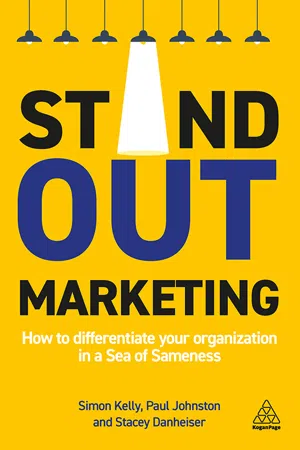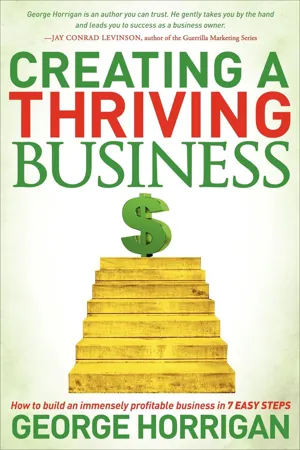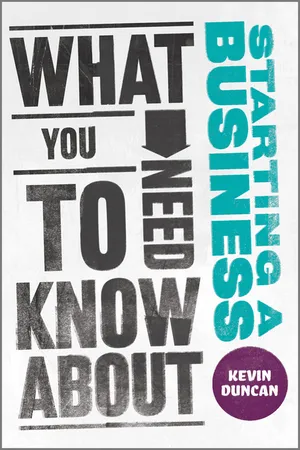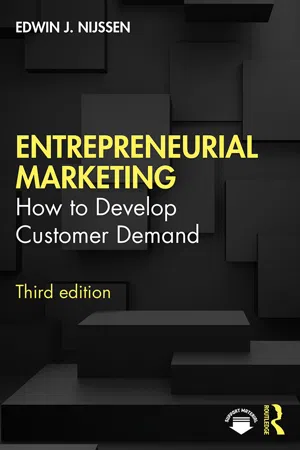Marketing
Marketing and Sales
Marketing involves creating, communicating, and delivering value to customers, often through advertising, branding, and market research. Sales, on the other hand, focuses on the direct process of selling products or services to customers. While marketing aims to generate interest and awareness, sales aims to convert that interest into actual purchases. Both functions are essential for driving revenue and growth.
Written by Perlego with AI-assistance
6 Key excerpts on "Marketing and Sales"
Learn about this page
Index pages curate the most relevant extracts from our library of academic textbooks. They’ve been created using an in-house natural language model (NLM), each adding context and meaning to key research topics.
- eBook - ePub
- John A. Lanier(Author)
- 2016(Publication Date)
- Routledge(Publisher)
“Marketing” and “sales” are often interchangeable synonyms within the middle market. Moreover, when the two are communicated as separate functions, the relationship between Marketing and Sales is typically backwards. For example, a business card might brandish “vice-president of sales and marketing.” When the term “marketing” is used, it is commonly subservient to sales. In these instances, “marketing” is tantamount to marketing communications—not strategic marketing. Marketing communications includes activities such as social media blasts in advance of an industry trade show to remind prospects and customers where to find the company’s booth. The value of marketing communications is not discounted here. Rather, the point is not to confuse it with strategic marketing. Indeed, marketing communications is an integral part of strategic marketing.Figure 7.1 A depiction of Porter’s basic strategiesSource: Reprinted with the permission of Simon & Schuster Publishing Group from the Free Press edition of Competitive Strategy: Techniques for Analyzing Industries and Competitors by Michael E. Porter. Copyright © 1980, 1988 by The Free Press. All rights reserved.The correct relationship between Marketing and Sales is similar to that between strategic thinking and strategic planning. The former is strategic (marketing and thinking) and the latter is tactical (sales and planning). Ideally, the Marketing and Sales functions should recognize themselves as partners in a three-legged race.Marketing
The population is by nature fickle; it is easy to persuade them of something, but difficult to confirm them in that persuasion. Therefore, one must urgently arrange matters so that when they no longer believe, they can be made to believe … .6Marketing strategy is developed and executed in existing and potential markets. According to Richard L. Daft, there are four stages of global market development. The first is domestic, which is germane to the home country. The second is international, often commenced by simple exporting before considering joint ventures, acquisitions, or greenfield operations. The third is multinational, whereby duplicative efforts pepper the globe. The fourth is global, in which a boundaryless, integrated company defers to the core competencies of the business model units based on economics—irrespective of geography.7 Competing in an increasingly boundaryless environment demands that strategy must encompass the issues of speed, flexibility, integration, and innovation.8 - eBook - ePub
- David Butler(Author)
- 2007(Publication Date)
- Routledge(Publisher)
Chapter 9 SalesChapter 9 andChapter 9 marketingThe vast majority of people who are setting out to start a new business can usually tell you about how their goods or services will be made or provided, what basic resources are needed and roughly what each item will cost, but their most common deficiency is a lack of marketing knowledge and sales skills. Unless they have worked in a marketing environment, they will often not know how to research their market and how to prepare a marketing plan. Similarly, without having worked in a sales capacity they are likely to be unaware of the skills needed to identify potential customers, to investigate and match their needs and to close the sale. In fact there are many who do not even realize that sales and marketing are two fundamentally different disciplines. Marketing is concerned with identifying the level of demand for the goods or services, where potential customers might be found, the competition which exists, and creating a mixture of product features and means of delivery that will ensure the goods or services will be desirable. Sales is about actually persuading the customer to buy the goods, to pay the right price for them and then to come back to you for more at a later date. It is quite possible to make excellent goods for which there is a potentially high demand in a readymade market, but without the sales skills to actually make the customer buy them they will just sit on the shelves.The objective of this chapter is, first, to describe the processes of market research, identifying suitable market segments, and then designing a marketing plan. Second, we will examine some basic sales skills and techniques that should assist the reader, and show how these can be implemented to meet the objectives of the marketing plan. - eBook - ePub
Stand-out Marketing
How to Differentiate Your Organization in a Sea of Sameness
- Simon Kelly, Paul Johnston, Stacey Danheiser(Authors)
- 2020(Publication Date)
- Kogan Page(Publisher)
The reason why everything we focus on as authors relates to both Marketing and Sales is because we believe that these two organizations must align and be in tune with customer needs in order to connect with what customers value and help their organization stand out. Practitioners saw sales having an important role in the ‘Cohesive loop’ between the customer, marketing, and sales. Equally they saw it as important to drive alignment to the company vision and mission while being ‘kept honest’ about changing trends on what customers value, based on feedback from the market.The role marketing has to play in getting organizational alignment, from the lofty goal of getting alignment with overall company strategy, to the more pragmatic role of alignment with sales, and crucially with the customer, is seen to be a core function of the named marketing organization.Strategy development
Building on the strategic need for better integration, we found it interesting that it was often people with sales backgrounds that placed some of the more strategic aspects of the marketing role in their top three. Marketers in B2B roles often feel they are under pressure to do lots of tactical things alongside providing golf balls and pens.The specific ask from sales leaders, particularly where they had worked in organizations that were competing against large incumbents to win customers from them and take share, was for better segmentation, targeting, and positioning (STP). Segmentation is about chunking the market into sets of customers with similar requirements and buying characteristics into distinct subgroups. Following on from segmentation organizations need to decide which customer segments the company will actively pursue, otherwise known as targeting. Once these decisions have been made the difficult job of positioning needs to take place in order to decide the way in which a company wants to be perceived by its target market relative to its competition, against things customers consider to be of valueKirk, based on a long career in sales, saw STP as the main responsibility, as the absence of targeting leads to a ‘spray and pray approach’. What comes out strongly here is marketing’s role to help sales focus their fire by pointing them towards the customers they really want to target, where they can have most impact. Without a clear steer on who these customers are you are left with a ‘spray and pray’ approach, which means try everybody and see where that gets you, strategy-free selling! Robson echoes the need for marketing to take on board the STP role and extends this on to a responsibility for building the appropriate product portfolio for the chosen target segments: - eBook - ePub
Creating a Thriving Business
How to Build an Immensely Profitable Business in 7 Easy Steps
- George Horrigan(Author)
- 2012(Publication Date)
- Morgan James Publishing(Publisher)
To recap what we have discussed so far, we have seen that everything flows from having a Vision for your business. We’ve concluded that this is not just something we check off of a to-do list, but instead, a compelling Vision is the factor that will drive your business forward. We discussed that you must cast your compelling Vision to your target audiences to achieve the goals for your business. Then we covered how to identify the make-or-break factors—the Critical Success Factors—for your business so you know the things that you must accomplish to achieve your Vision. Lastly, we introduced the concept of having a Strategic Plan or a Strategy for accomplishing all of the above.We are now ready to cast your compelling Vision to your target Customer to obtain revenue for your business.THE IMPORTANCE OF YOUR Marketing and Sales AREA
Why is the Marketing and Sales area of a business so important? Bill Gates, the founder of Microsoft Corporation, considers it this important: “If I only had two dollars left I would spend one dollar on PR” (PR being part of Marketing and Sales).The Marketing and Sales area is absolutely imperative to your business—it is what generates revenue; without revenue, no matter how wonderful your product, your business will cease to exist unless you continually keep it afloat it with your own funds! You must generate revenue to stay in business.Some business owners feel they have no need for Marketing and Sales efforts because their product sells itself. Unfortunately, virtually nothing sells itself. As we will see, there is always some type of marketing that has to be done to sell your product, no matter how easy it is to sell.Many business owners undervalue Marketing and Sales and consider Production or Finance by far the highest priority area of the business. Some business owners view Marketing and Sales as a necessary evil that has to be tolerated just to be in business. The truth is that if you go to all the trouble to create a wonderful product that meets your Customers’ needs or wants—but they don’t know about it or you cannot convince them to buy it—then you have wasted your time and resources. The validation of a business is when a customer pays you for a product, and the ultimate validation of a business is when a customer repeats the process by paying you for your product a second, third, and fourth time. - eBook - ePub
- Kevin Duncan(Author)
- 2011(Publication Date)
- Capstone(Publisher)
It all starts with you. You need to tell anyone who will listen what type of business you are. That’s half the battle. Then tell your staff (if you have them). They need to behave in a way that is appropriate to what you stand for, and what you believe to be right. They can only do this if they are told what is expected of them. And, of course, you need to behave that way yourself.How much should you spend on sales and marketing? First, we need to examine the distinction between sales and marketing. In the purest sense, sales are purely financial transactions, and in theory they can occur in the absence of marketing. Equally, marketing can generate a lot of activity publicizing products and services, but not actually lead to any sales. In this respect, they can be viewed as separate items, but in most companies they are not. The two disciplines are generally regarded as indivisible – marketing should always lead to sales, and sales usually needs the help of marketing. Most organizations therefore now combine the two things. Much has been written about appropriate marketing investment levels. As a rough rule of thumb, mature companies that embrace marketing as a discipline spend 8–13% of their turnover on it. They don’t do this for fun, but for hard-nosed commercial reasons that have been proven to improve their fortunes. Most modern companies have concluded that there is essentially no difference between Marketing and Sales. As such, they believe that to have ‘no marketing’ is to abdicate from sales altogether. The answer for small businesses may be quite different. There is a huge difference between paid-for marketing and free marketing. Your most powerful weapon in the early days is you. You need to get out and about and promote what you do vigorously. To start with, you may not have to spend any money on marketing at all.Start by saying hello to everyone who could help. It is extraordinary the number of people who haven’t even bothered to let everyone know what they do for a living. This is one of the most powerful forms of marketing, and yet many leave it out completely. Word of mouth is free, and much more persuasive than any marketing you might pay for. Everybody you meet could be a potential customer, but that isn’t the main point. Far more important is the fact that, even if they don’t want what you have to offer, they might know someone who does. Creating a buzz around what you do is important, and it needn’t cost anything. - eBook - ePub
Entrepreneurial Marketing
How to Develop Customer Demand
- Edwin J. Nijssen(Author)
- 2021(Publication Date)
- Routledge(Publisher)
Chapter 8Developing a Marketing and Sales programme
DOI: 10.4324/9781003010197-8Key issues- Discuss the idea of a simple one-page plan to guide Marketing and Sales activities.
- Identify the three core elements of the plan: build customer value, market presence, and customer relationships.
- Discuss the relationship between the core elements and the marketing mix: promotion (communications), product, place (channel), and price.
- Detail the four Ps of the marketing mix.
- Understand the importance of creativity to compensate for a limited marketing budget.
8.1 A one-page Marketing and Sales planA Marketing and Sales plan identifies the goals, market strategy, and Marketing and Sales tactics that will be used to approach the market. It details the actions. By updating the plan weekly, new ideas evolve that help to plan actions based on what is learned. The aim is to (1) specify the product-market fit and thus the customer value; (2) create product awareness and market presence; and (3) approach and turn prospects into customers.At first, the plan will not require more than one to two pages.1 Later, as more assumptions have been validated and more is known about the target customers and their needs, as well as about the value proposition, the plan can be expanded. Writing down the marketing decisions and actions will force the entrepreneur to specify the overall customer development goals, but also specific Marketing and Sales goals, strategies, and tactics. Much of the initial plan only concerns assumptions about the market, customers’ problems, value, and customer response. To prevent confusion between facts and fiction, one could print assumptions in red and change them to black or blue print after they have been validated.Working with subsequent customers, and using additional experimentation, the product configuration, price, distribution, and sales message can be further developed and tested. With a more complete profile of the target customer, the Marketing and Sales plan will become more detailed, substantial, and better structured. Routines will develop and more professional Marketing and Sales materials created. While in the beginning the plan may seem like an action list, later it becomes a Marketing and Sales report. Materials that back up the decisions you make at each stage of the process should be collected and included in the document or filed at the back of the plan as appendices. As the lean start-up approach recommends, it is important to make explicit assumptions at each stage of customer development and then test them.





